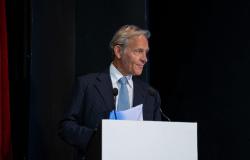
It was March 22, 1982, forty-two years ago, when the Como City Council, mayor Antonio Spallino, voted for the purchase of Ticosa. The objective of the operation? Ensuring that that almost unique space of 41 thousand square meters was made available to the city. And almost twenty years have passed since that evening in 2007 when, between speeches and fireworks, the then mayor Stefano Bruni “freed” the city from the physical memory of that glorious industrial past by demolishing the buildings of the old dyeing and printing factory.
Since then the list of failed dreams and projects has grown year after year, including sales to private individuals and the discovery of asbestos underground, waste reclamation contracts, incorrect tenders and many, many projects that have remained only on paper. Until the last one, presented at the beginning of this year by Acinque, for the construction of a maxi car park with almost a thousand stalls (including cars, buses, campers and bicycles) with a photovoltaic system, greenery and a commercial hub (but without understand the recovery of Santarella). All for 27 million euros, of which almost two thirds are paid by the Municipality and the remainder by Acinque, in addition to 30 years of concession for both the car park and the commercial spaces, including photovoltaic proceeds. A financial plan that has raised some doubts from many quarters, so much so that it pushed the Municipality itself, after the initial enthusiasm, to ask the company for an update.
And while we await Acinque’s new proposal, there are those who take the opportunity to remember that, perhaps, it might be worth giving a different meaning to the dream of donating Ticosa to the city which was the intention of those who purchased it. This is done by the Como architect Ado Franchini who dusts off one of his proposals presented in 2022 by Civitas, to which he has been close for some time, the “Ticosa Felice 2030” project.
Architect, what did your project involve?
I am still collecting updated data on traffic flows, which are not only made up of cars but also bicycles and pedestrians, and on the number of car parks currently existing in the city and under construction, but I believe that this will not substantially change my idea from two years ago, that is, that of a space that contained a set of multigenerational functions and services for the city, for leisure, for the present, but above all for the future.
So what would you imagine in concrete terms?
The preliminary project that I had presented envisaged parking for around 230 spaces, public greenery with a lake fed by the canals that already cross the area, possible urban vegetable gardens, spaces and headquarters for elderly clubs, perhaps reconstructing here the bowling greens lost with the closure of the Fighters. And then, a square for a neighborhood market or collective activities of different types, basketball, five-a-side, tennis courts and a skatepark, perhaps managed by the same associations of elderly people as already happens in various European cities in a mix between generations that can be only positive. And, from this perspective, residences for young people but also for self-sufficient elderly people and laboratories based on the ComoNext model for innovative companies. And the Santarella would become a space available to the University and the Silk Museum with rooms for conferences and exhibitions.
A challenging project. In how many years did you imagine it could be achieved?
It would be a project to be carried out in different phases, for a total of approximately 6-8 years.
In your opinion, is providing practically only parking spaces, as Acinque would like, a mistake for a city starved of parking like Como?
Absolutely yes. Ticosa is such a precious asset for the city that it cannot be reduced only to this. I understand that the parking issue can have a strong impact on citizens, as well as the idea of finally getting rid of such a long-standing problem as that of this area, but the future of a city is not based on parking but on the services they need its inhabitants. The major European cities are moving towards spaces that are increasingly available to people and we, however, continue to repeat to ourselves that it is impossible to find different solutions without reminding ourselves that Como’s problems are not only caused by traffic.
However, the lack of parking remains an objective problem for the city.
It’s true, and in fact my project also envisages its realization, but the idea of concentrating a thousand cars in a large car park in the city is anachronistic. There are effective solutions such as elevated monorails to keep cars away from the center that many cities have been adopting for decades and that we don’t even take into consideration.
What solutions could a solution like the one you propose offer the city? With what prospects?
It would be a happy place for all citizens, in which to meet, play sports, relax, organize events, but also offer opportunities to young people who, otherwise, would have little reason not to go and live elsewhere and, last but not least, to the elderly for whom the the city offers very little. And it would also be an alternative to the lakefront, now a monopoly for tourists. All immediate and tangible benefits that are very different from the economic return of a car park which, moreover, at the expiry of the thirty-year concession would return to the Municipality like a pile of old photovoltaic panels to be disposed of.
Do you expect the current municipal administration to consider a proposal like this? After all, Ticosa becoming a car park with photovoltaic panels was the first point of the mayor’s electoral programme.
It’s true, but Rapinese is the mayor even of those who didn’t vote for him and I would like it to be possible to discuss the future of Ticosa with the citizens before making decisions from which we can never go back. And I also hope that the city wakes up and stops even accepting to lose out, just to get rid of the problems. This is the last strategic area we have available and it was purchased by the city as an investment in its own future and in the quality of life of those who live there, not because others would gain economic benefits from it.



